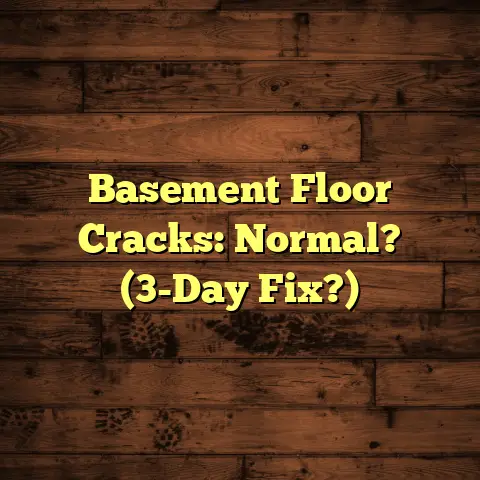Murphy’s Oil on Wood? (3 Floor Disasters!)
The goal here is simple: I want to arm you with the knowledge to avoid these common pitfalls.
We’ll dive into real-life scenarios, dissect the mistakes, and, most importantly, learn how to keep your wood floors looking their best.
Let’s get started!
Murphy’s Oil Soap: Friend or Foe?
Murphy’s Oil Soap.
You’ve probably seen it.
Maybe you’ve even used it.
It’s been around for ages, promising to clean and revitalize your wood surfaces.
And, honestly, when used correctly, it can do just that.
The problem is, “correctly” is the key word.
I’ve seen so many homeowners fall victim to misinformation or just plain overzealousness.
Thinking more is better and ending up with a disaster on their hands.
My experience has shown me that while Murphy’s Oil Soap can be a gentle cleaner for wood, improper application can lead to significant flooring disasters.
I’m talking sticky residue, discoloration, and even dangerously slippery floors.
So, buckle up, because we’re about to explore three common Murphy’s Oil Soap mishaps that I’ve personally witnessed.
Learn from these mistakes so you don’t repeat them!
Section 1: Disaster #1 – The Sticky Situation
Okay, let’s kick things off with a classic: the sticky floor fiasco.
The Tale of the Overzealous Cleaner
I remember getting a call from a frantic homeowner, let’s call her Sarah.
Sarah had just cleaned her beautiful oak floors with Murphy’s Oil Soap, but something was terribly wrong.
Instead of a sparkling clean surface, she was left with a sticky, almost tacky feeling underfoot.
She described it as if her shoes were glued to the floor.
Every step created a slight “schhhhlp” sound.
She had followed the directions… sort of.
She admitted to me that she figured a little extra Murphy’s Oil Soap would make the floor even cleaner and shinier.
Sound familiar?
When I arrived, the situation was exactly as she described.
The floor had a dull, slightly cloudy appearance, and the stickiness was undeniable.
It was clear that Sarah had applied way too much product.
It was a mess.
Why So Sticky? The Analysis of a Mistake
So, what went wrong?
The problem lies in the concentration and dilution of Murphy’s Oil Soap.
This product, like many cleaning agents, is designed to be diluted with water.
The proper ratio ensures that the cleaning agents lift dirt and grime without leaving behind a heavy residue.
When you use too much Murphy’s Oil Soap, or don’t dilute it enough, you’re essentially leaving a layer of concentrated soap on the floor.
This layer doesn’t fully dry and attracts dirt and dust.
The result?
A sticky, unpleasant surface that’s a nightmare to clean.
Also, consider the finish on your wood floors.
Oil-based finishes are generally more forgiving, but even they can suffer from excessive product buildup.
Water-based finishes, which are more common these days, are particularly susceptible to this issue.
They tend to be less porous.
Therefore, they don’t absorb excess product as readily.
According to the National Wood Flooring Association (NWFA), understanding your floor’s finish is crucial for proper maintenance.
Different finishes require different cleaning methods.
The Sticky Consequences
Ignoring this sticky situation can lead to long-term problems.
The sticky residue continues to attract dirt, making the floor look dull and grimy.
Over time, this buildup can damage the finish, requiring professional cleaning or even refinishing.
Refinishing a wood floor can cost anywhere from $3 to $8 per square foot.
Imagine having to refinish an entire house because of a cleaning mistake!
Here’s a breakdown of potential costs:
In Sarah’s case, fortunately, we were able to resolve the issue with a deep cleaning using a specialized cleaning solution.
But it was a close call!
She learned a valuable lesson about following instructions.
Section 2: Disaster #2 – The Mysterious Discoloration
Now, let’s move on to a more subtle, but equally frustrating, problem: discoloration.
The Case of the Fading Finish
I had a client, Mark, who was very proud of his newly installed maple floors.
He wanted to keep them looking pristine.
He decided to use Murphy’s Oil Soap, based on a recommendation from a friend.
A few weeks later, Mark called me, sounding concerned.
He noticed that his floors were starting to look uneven in color.
Some areas appeared lighter, almost bleached, while others remained the original shade.
He was perplexed.
He had followed the instructions on the bottle, and he couldn’t understand why his floors were changing color.
He thought he was doing everything right!
Upon inspection, I observed that the discoloration was indeed present, particularly in areas with high foot traffic and sunlight exposure.
Unraveling the Mystery: The Chemical Reaction
The discoloration issue often arises from a chemical reaction between Murphy’s Oil Soap and certain wood finishes or stains.
This is especially true for floors with older or less durable finishes.
Murphy’s Oil Soap contains ingredients that can act as mild solvents.
These ingredients can gradually break down or alter the existing finish.
This is particularly true if the finish isn’t fully cured or is already compromised.
Furthermore, some wood species are more prone to discoloration than others.
Maple, for example, is known to be sensitive to certain chemicals.
The key takeaway here is that not all wood finishes are created equal.
What works on one floor might wreak havoc on another.
Before applying any cleaning product to your entire floor, always test it in an inconspicuous area.
This simple step can save you from a costly and unsightly disaster.
The Price of Discoloration
Discoloration is more than just an aesthetic problem.
It can significantly impact the value of your home.
Potential buyers are often turned off by uneven or faded flooring.
Correcting discoloration often requires complete refinishing.
This involves sanding down the existing finish, re-staining the floor (if desired), and applying a new protective coating.
According to a 2023 report by the National Association of Realtors (NAR), refinishing hardwood floors can increase a home’s value by as much as 3% to 5%.
However, the cost of refinishing must be factored in.
Here’s a quick look at how flooring condition affects home value:
In Mark’s case, he opted to refinish his floors to restore their original beauty.
It was an expensive lesson, but he learned the importance of testing products and understanding his floor’s finish.
Section 3: Disaster #3 – The Slippery Slope
Let’s talk about a disaster that’s not only frustrating but also potentially dangerous: slippery floors.
The Tale of the Unexpected Ice Rink
I received an urgent call from a client, Emily.
She had cleaned her stairs with Murphy’s Oil Soap and, shortly afterward, her mother slipped and fell, sustaining a minor injury.
Emily was horrified.
She had always trusted Murphy’s Oil Soap and had never experienced any problems before.
But this time, something went terribly wrong.
When I arrived, I immediately noticed that the stairs were indeed dangerously slippery.
It felt like walking on ice.
It was clear that the improper use of Murphy’s Oil Soap had created a hazardous condition.
The Science of Slip and Slide
The slippery floor phenomenon is caused by the film left behind by incorrect oil application.
When you use too much product, or don’t allow it to dry properly, a thin layer of residue remains on the surface.
This residue acts as a lubricant.
It reduces the friction between your shoes and the floor, making it incredibly easy to slip and fall.
Moreover, certain types of flooring, such as laminate or engineered wood with a glossy finish, are more prone to becoming slippery when treated with oil-based products.
The key to preventing this is using the right amount of product and ensuring proper drying times.
Always follow the manufacturer’s instructions carefully.
And consider using a dry microfiber cloth to buff the floor after cleaning to remove any excess residue.
The High Cost of a Fall
Slippery floors are a serious safety hazard.
Falls can lead to injuries ranging from minor bruises to severe fractures, especially for elderly individuals.
According to the Centers for Disease Control and Prevention (CDC), falls are the leading cause of injury and death from injury among older Americans.
Furthermore, if someone is injured on your property due to negligence, you could be held liable for their medical expenses and other damages.
This could potentially lead to a lawsuit.
Here’s a breakdown of the potential costs associated with a fall:
In Emily’s case, thankfully, her mother’s injuries were minor.
But the incident served as a stark reminder of the importance of safety.
She switched to a non-slip floor cleaner and installed handrails on the stairs to prevent future accidents.
Conclusion: Learning from Disaster
So, there you have it: three flooring disasters I’ve witnessed firsthand, all stemming from the misuse of Murphy’s Oil Soap.
Let’s recap the key lessons:
- Disaster #1: The Sticky Situation: Always dilute Murphy’s Oil Soap according to the manufacturer’s instructions.
Using too much product will leave a sticky residue. - Disaster #2: The Mysterious Discoloration: Test the product in an inconspicuous area before applying it to the entire floor.
Be aware of the potential chemical reactions between the soap and your floor’s finish. - Disaster #3: The Slippery Slope: Use the right amount of product and ensure proper drying times.
Excess residue can create a dangerously slippery surface.
The bottom line is this: understanding your wood flooring and following manufacturer guidelines is crucial.
Don’t assume that all cleaning products are created equal, and always err on the side of caution.
If you’re ever in doubt about how to properly care for your wood floors, seek professional advice.
A qualified flooring contractor can assess your specific needs and recommend the best cleaning and maintenance methods.
Have you had any flooring disasters of your own?
Share your experiences in the comments below!
Your story could help someone else avoid a costly mistake.
And remember, a little knowledge goes a long way in keeping your wood floors beautiful and safe for years to come.





